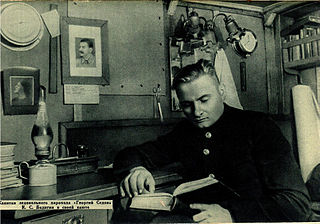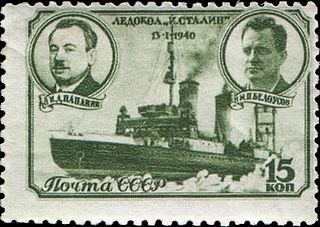
An icebreaker is a special-purpose ship or boat designed to move and navigate through ice-covered waters, and provide safe waterways for other boats and ships. Although the term usually refers to ice-breaking ships, it may also refer to smaller vessels, such as the icebreaking boats that were once used on the canals of the United Kingdom.

A nuclear-powered icebreaker is a nuclear-powered ship, purpose-built for use in waters covered with ice. While nuclear-powered icebreakers have been considered or planned by other countries, the only country that has built and operated them as of 2022 is Russia. Nuclear-powered icebreakers have been constructed by the Soviet Union and later Russia primarily to aid shipping along the Northern Sea Route in the frozen Arctic waterways north of Siberia. Nuclear-powered icebreakers are much more powerful than their diesel-powered counterparts, and although nuclear propulsion is expensive to install and maintain, very heavy fuel demands and limitations on range, compounded with the difficulty of refueling in the Arctic region, can make diesel vessels less practical and economical overall for these ice-breaking duties.
The name Sibir can refer to:

Lenin was a Russian icebreaker originally built in England for the Russian Empire. Launched in 1916, before going into service for Russia, the ship first served in the Royal Navy during the Allied intervention in the Russian Civil War. It was eventually acquired by the Soviet Union and served through World War II, and was finally scrapped in 1977.
Joseph Stalin (1878–1953) was a Bolshevik revolutionary and the second leader of the Soviet Union from the mid-1920s until his death in 1953.
Sadko was a Russian and Soviet icebreaker ship of 3,800 tonnes displacement. She was named after Sadko, a hero of a Russian bylina.

The Arktika class is a Russian class of nuclear-powered icebreakers. Formerly known as Project 10520 nuclear-powered icebreaker, they were the world's largest and most powerful icebreakers until the 2016 launch of the first Project 22220 icebreaker, also named Arktika. Ships of the Arktika class are owned by the federal government, but were operated by the Murmansk Shipping Company (MSCO) until 2008, when they were transferred to the fully government-owned operator Atomflot. Of the ten civilian nuclear-powered vessels built by Russia, six have been of this type. They are used for escorting merchant ships in the Arctic Ocean north of Siberia as well as for scientific and recreational expeditions to the Arctic.

Arktika is a retired nuclear-powered icebreaker of the Soviet Arktika class. In service from 1975 to 2008, she was the first surface ship to reach the North Pole, a feat achieved on August 17, 1977, during an expedition dedicated to the 60th anniversary of the October Revolution.

USCGC Westwind (WAGB-281) was a Wind-class icebreaker that served in the United States Coast Guard as USCGC Westwind (WAG-281), the Soviet Navy as the Severni Polius, and again in the U.S. Coast Guard as USCGC Westwind (WAGB-281).
The OJSC Baltic Shipyard(Baltiysky Zavod, formerly Shipyard 189) is one of the oldest shipyards in Russia and is part of United Shipbuilding Corporation today.

Captain Konstantin Sergeyevich Badygin was a Soviet naval officer, explorer, author, and scientist.

The Taymyr was an icebreaking steamer of 1200 tons built for the Russian Imperial Navy at St. Petersburg in 1909. It was named after the Taymyr Peninsula.

The Sibir was the first Soviet icebreaker built at a domestic shipyard.
Malygin (Малыгин) may refer to one of the following icebreakers:

Sibir, built 1977, is a retired Russian nuclear-powered icebreaker of the Arktika class. She is the only icebreaker of her class that does not feature a red superstructure.

Project 22220, also known through the Russian type size series designation LK-60Ya, is a series of Russian nuclear-powered icebreakers. They are currently the largest and most powerful icebreakers ever constructed, surpassing their predecessors of the Arktika class.
Sibir is a Russian Project 22220 nuclear-powered icebreaker. Built by Baltic Shipyard in Saint Petersburg, she was laid down in 2015, launched in 2017, and delivered in December 2021.
A number of icebreakers have been named Ilya Muromets after the Russian folk hero:
Three icebreakers have been named Georgiy Sedov:
This page is based on this
Wikipedia article Text is available under the
CC BY-SA 4.0 license; additional terms may apply.
Images, videos and audio are available under their respective licenses.










